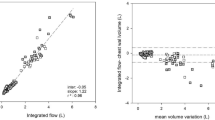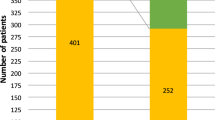Abstract
Objective:
Mechanisms of dyspnea in obesity remain unclear. This study was undertaken to determine the relationships between dyspnea and pulmonary function including inspiratory muscle endurance (IME) in morbidly obese patients before bariatric surgery.
Research methods and procedures:
Fifty-five patients with a mean±s.d. body mass index (BMI) of 49.4±7.0 kg/m2 were included. Dyspnea was evaluated by the Baseline Dyspnea Index (BDI; 0–12, 0=maximal dyspnea). Pulmonary function tests included a plethysmography, maximal inspiratory pressure (PImax) and IME was assessed by the incremental threshold loading test, determining the maximal pressure sustained for 2 min (Plim2) and Plim2/PImax ratio. Patients were classified according to their BMI in two groups: BMI ⩽49 (n=27) and >49 kg/m2 (n=28).
Results:
Breathlessness was higher in the BMI >49 kg/m2 group compared to the BMI ⩽49 kg/m2 group (BDI score at 6.9±2.2 in the BMI >49 kg/m2 group vs 8.9±2.5 in the BMI ⩽49 kg/m2 group, P<0.01). Patients with BMI >49 kg/m2 had significantly higher PaCO2 level and significantly lower vital capacity, inspiratory capacity and PImax values compared with the BMI ⩽49 kg/m2 group. Correlations between BDI and lung function were moderate: forced expiratory volume in 1 s (FEV1)% pred: Rho=0.27; P=0.05; vital capacity % pred: Rho=0.40; P=0.004; and Plim2/PImax: Rho=0.40; P=0.003. Higher correlations with dyspnea were found in the BMI ⩽49 kg/m2 group: FEV1% pred: Rho=0.38; P=0.05; and Plim2/PImax: Rho=0.49; P=0.01.
Discussion:
Inspiratory muscle performance is moderately reduced in morbid obesity. Dyspnea in these patients remains moderately related to lung function and inspiratory muscle performance. However, inspiratory muscles performance correlates more significantly with dyspnea in patients with a BMI ⩽49 kg/m2.
This is a preview of subscription content, access via your institution
Access options
Subscribe to this journal
Receive 12 print issues and online access
$259.00 per year
only $21.58 per issue
Buy this article
- Purchase on Springer Link
- Instant access to full article PDF
Prices may be subject to local taxes which are calculated during checkout


Similar content being viewed by others
References
Bray GA . Classification and evaluation of the obesities. Med Clin N Am 1989; 73: 161–184.
Young T, Peppard PE, Gottlieb DJ . Epidemiology of obstructive sleep apnea: a population health perspective. Am J Respir Crit Care Med 2002; 165: 1217–1239.
Krachman S, Criner GJ . Hypoventilation syndromes. Clin Chest Med 1998; 19: 139–155.
Barrera F, Reidenberg MM, Winters WL . Pulmonary function in the obese patient. Am J Med Sci 1967; 254: 785–796.
Bedell GN, Wilson WR, Seebohm PM . Pulmonary function in obese persons. J Clin Invest 1958; 37: 1049–1060.
Ray CS, Sue DY, Bray G, Hansen JE, Wasserman K . Effects of obesity on respiratory function. Am Rev Respir Dis 1983; 128: 501–506.
Suratt PM, Wilhoit SC, Hsiao HS, Atkinson RL, Rochester DF . Compliance of chest wall in obese subjects. J Appl Physiol 1984; 57: 403–407.
Pelosi P, Croci M, Ravagnan I, Cerisara M, Vicardi P, Lissoni A et al. Respiratory system mechanics in sedated, paralyzed, morbidly obese patients. J Appl Physiol 1997; 82: 811–818.
Biring MS, Lewis MI, Liu JT, Mohsenifar Z . Pulmonary physiologic changes of morbid obesity. Am J Med Sci 1999; 318: 293–297.
Sahebjami H, Gartside PS . Pulmonary function in obese subjects with a normal FEV1/FVC ratio. Chest 1996; 110: 1425–1429.
Sharp JT, Henry JP, Sweany SK, Meadows WR, Pietras RJ . The total work of breathing in normal and obese men. J Clin Invest 1964; 43: 728–739.
Sahebjami H . Dyspnea in obese healthy men. Chest 1998; 114: 1373–1377.
Mahler DA, Weinberg DH, Wells CK, Feinstein AR . Measurement of dyspnea, contents, interobserver agreement, and physiologic correlates of two new clinical indexes. Chest 1984; 85: 751–758.
Standardized lung function testing. Official statement of the European respiratory society. Eur Respir J Suppl 1993; 16: 1–100.
Uldry C, Fitting JW . Maximal values of sniff nasal inspiratory pressure in healthy subjects. Thorax 1995; 50: 371–375.
Martyn JB, Moreno RH, Pare PD, Pardy RL . Measurement of inspiratory muscle performance with incremental threshold loading. Am Rev Respir Dis 1987; 135: 919–923.
Gosselink R, Wagenaar RC, Decramer M . Reliability of a commercially available threshold loading device in healthy subjects and in patients with chronic obstructive pulmonary disease. Thorax 1996; 51: 601–605.
Brancaleone P, Perez T, Robin S, Neviere R, Wallaert B . Clinical impact of inspiratory muscle impairment in sarcoidosis. Sarcoidosis Vasc Diffuse Lung Dis 2004; 21: 219–227.
ATS/ERS Statement on respiratory muscle testing. Am J Respir Crit Care Med 2002; 166: 518–624.
Rechtschaffen A, Kales A . A manual of standardized terminology, techniques and scoring system for sleep stages of human subjects National Institute of Health US Governement Printing office, Washington, Publication No. 204 1968.
Mahler DA, Guyatt BH, Jones PW . Clinical measurement of dyspnea. Dyspnea 1998; 149–181.
Collins LC, Hoberty PD, Walker JF, Fletcher EC, Peiris AN . The effect of body fat distribution on pulmonary function tests. Chest 1995; 107: 1298–1302.
Maiolo C, Mohamed EI, Di DN, Pepe M, Periello G, De LA . Body composition and pulmonary function in obese type 2 diabetic women. Diabetes Nutr Metab 2002; 15: 20–25.
Kessler R, Chaouat A, Schinkewitch P, Faller M, Casel S, Krieger J et al. The obesity-hypoventilation syndrome revisited: a prospective study of 34 consecutive cases. Chest 2001; 120: 369–376.
Perez T, Becquart LA, Stach B, Wallaert B, Tonnel AB . Inspiratory muscle strength and endurance in steroid-dependent asthma. Am J Respir Crit Care Med 1996; 153: 610–615.
Wirnsberger RM, Drent M, Hekelaar N, Breteler MH, Drent S, Wouters EF et al. Relationship between respiratory muscle function and quality of life in sarcoidosis. Eur Respir J 1997; 10: 1450–1455.
Dillard TA, Hnatiuk OW, McCumber TR . Maximum voluntary ventilation. Spirometric determinants in chronic obstructive pulmonary disease patients and normal subjects. Am Rev Respir Dis 1993; 147: 870–875.
Weiner P, Waizman J, Weiner M, Rabner M, Magadle R, Zamir D . Influence of excessive weight loss after gastroplasty for morbid obesity on respiratory muscle performance. Thorax 1998; 53: 39–42.
Chen HI, Tang YR . Sleep loss impairs inspiratory muscle endurance. Am Rev Respir Dis 1989; 140: 907–909.
Montserrat JM, Kosmas EN, Cosio MG, Kimoff RJ . Lack of evidence for diaphragmatic fatigue over the course of the night in obstructive sleep apnoea. Eur Respir J 1997; 10: 133–138.
Cibella F, Cuttitta G, Romano S, Bellia V, Bonsignore G . Evaluation of diaphragmatic fatigue in obstructive sleep apnoeas during non-REM sleep. Thorax 1997; 52: 731–735.
Farkas GA, Gosselin LE, Zhan WZ, Schlenker EH, Sieck GC . Histochemical and mechanical properties of diaphragm muscle in morbidly obese Zucker rats. J Appl Physiol 1994; 77: 2250–2259.
Tankersley CG, O'Donnell C, Daood MJ et al. Leptin attenuates respiratory complications associated with the obese phenotype. J Appl Physiol 1998; 85: 2261–2269.
Kress JP, Pohlman AS, Alverdy J, Hall JB . The impact of morbid obesity on oxygen cost of breathing (VO (2RESP)) at rest. Am J Respir Crit Care Med 1999; 160: 883–886.
Killian JK, Campbell EJ . Dyspnea. The Lung: Scientific Foundations 2nd edn. Lippincott Williams and Wilkins, Philadelphia, 1997; 1865–1881.
Ferretti A, Giampiccolo P, Cavalli A, Milic-Emili J, Tantucci C . Expiratory flow limitation and orthopnea in massively obese subjects. Chest 2001; 119: 1401–1408.
Zarich SW, Kowalchuk GJ, McGuire MP, Benotti PN, Mascioloi EA, Nesto RW . Left ventricular filling abnormalities in asymptomatic morbid obesity. Am J Cardiol 1991; 68: 377–381.
Lennmarken C, Sandstedt S, von Schenck H, Larsson J . Skeletal muscle function and metabolism in obese women. J Parenter Enteral Nutr 1986; 10: 583–587.
Author information
Authors and Affiliations
Corresponding author
Rights and permissions
About this article
Cite this article
Collet, F., Mallart, A., Bervar, J. et al. Physiologic correlates of dyspnea in patients with morbid obesity. Int J Obes 31, 700–706 (2007). https://doi.org/10.1038/sj.ijo.0803460
Received:
Revised:
Accepted:
Published:
Issue Date:
DOI: https://doi.org/10.1038/sj.ijo.0803460
Keywords
This article is cited by
-
Pulmonary and chest wall function in obese adults
Scientific Reports (2023)
-
Association between obesity-related dyspnea in daily living, lung function and body composition analyzed by DXA: a prospective study of 130 patients
BMC Pulmonary Medicine (2022)
-
Visceral adiposity and respiratory outcomes in children and adults: a systematic review
International Journal of Obesity (2022)
-
Obesity in COVID-19 era, implications for mechanisms, comorbidities, and prognosis: a review and meta-analysis
International Journal of Obesity (2021)
-
Obesity Hypoventilation Syndrome
Current Sleep Medicine Reports (2016)



